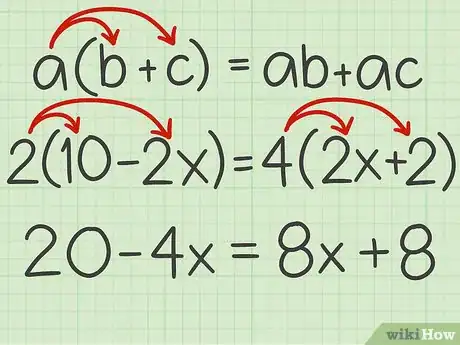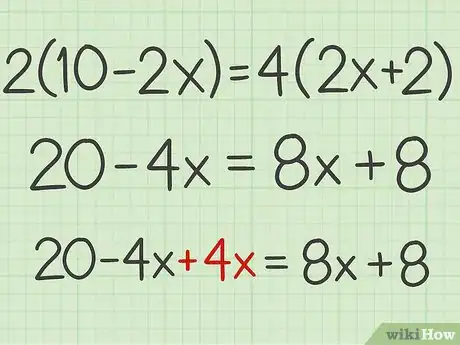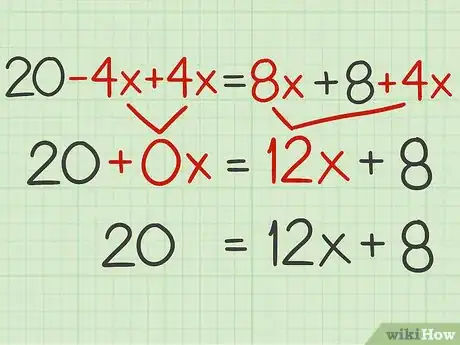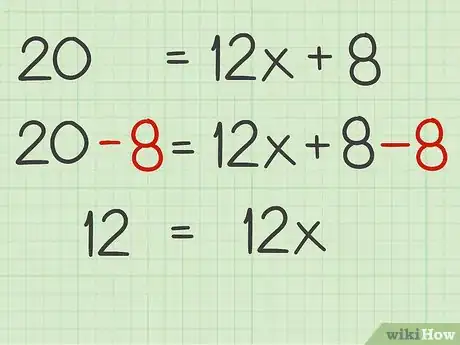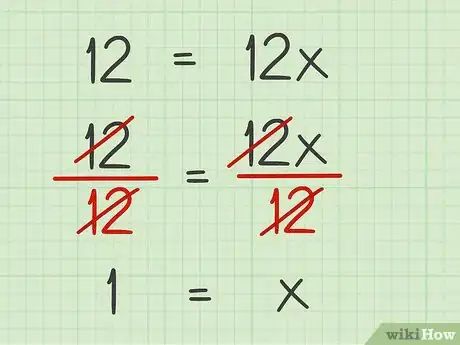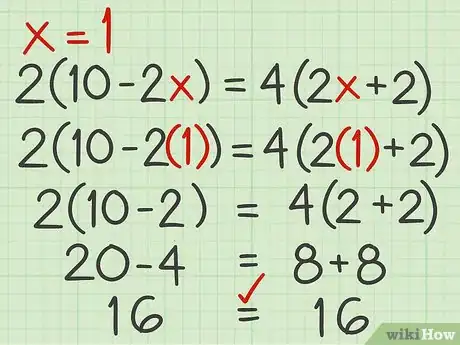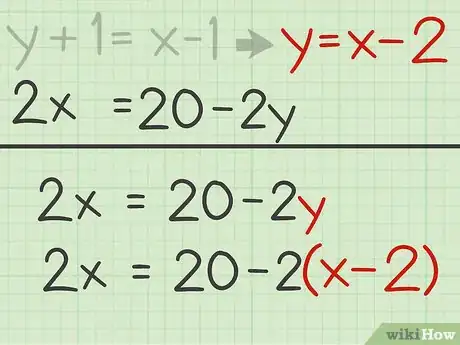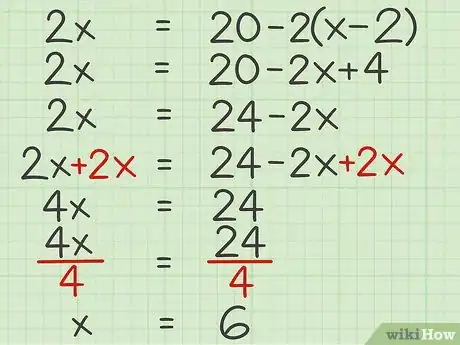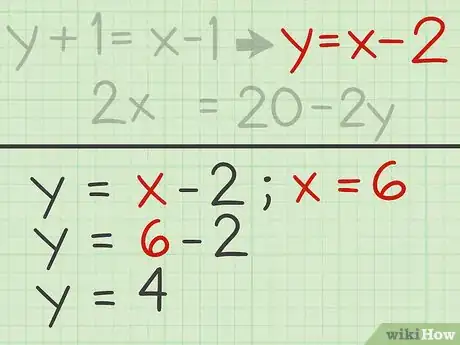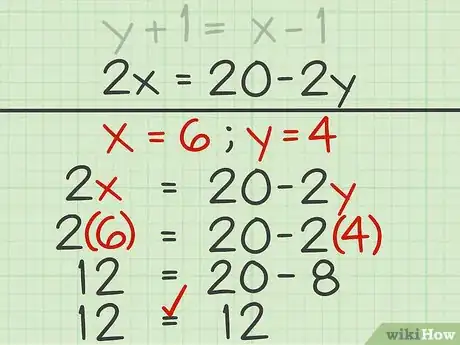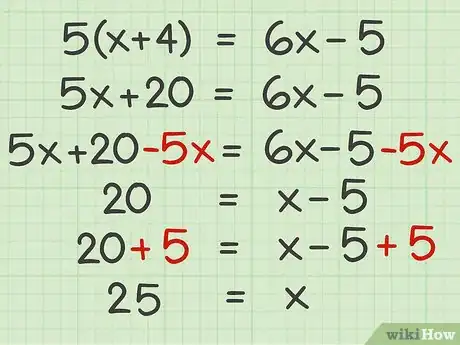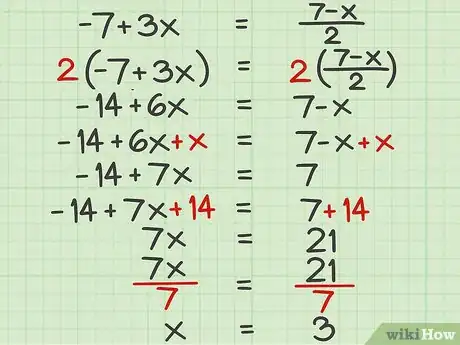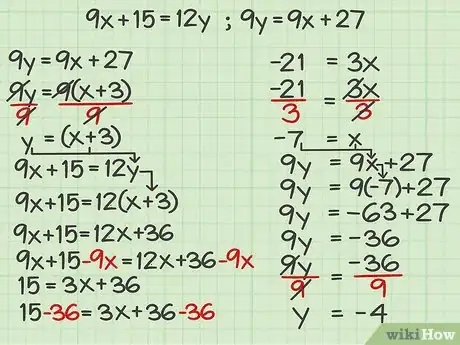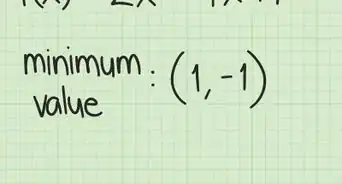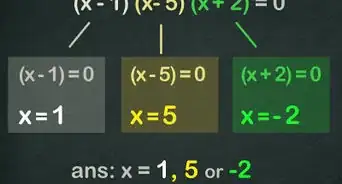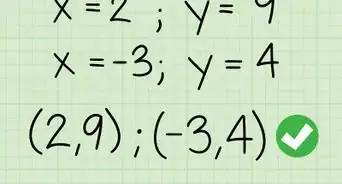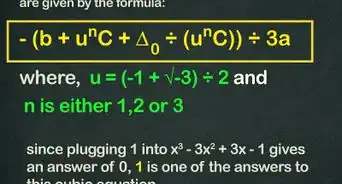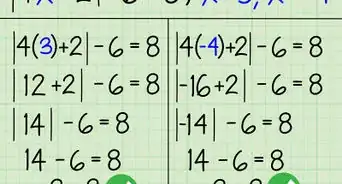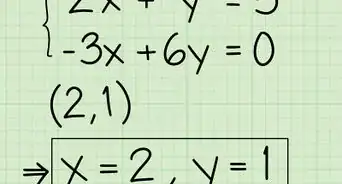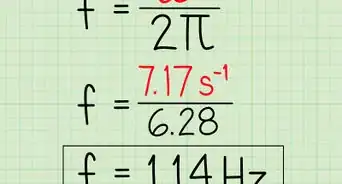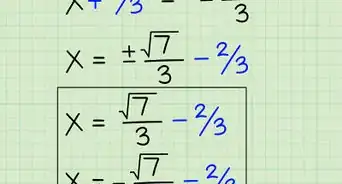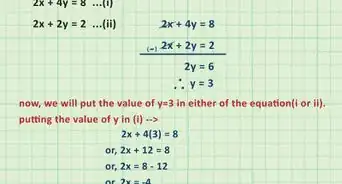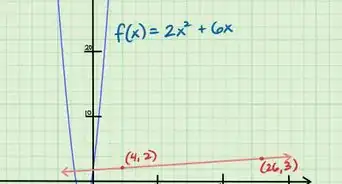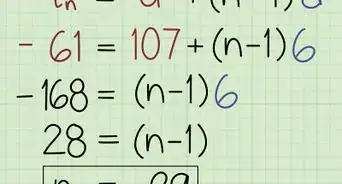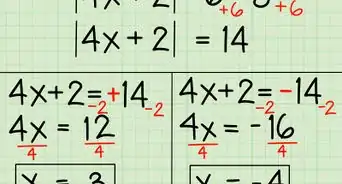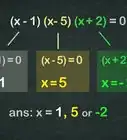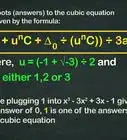This article was co-authored by wikiHow Staff. Our trained team of editors and researchers validate articles for accuracy and comprehensiveness. wikiHow's Content Management Team carefully monitors the work from our editorial staff to ensure that each article is backed by trusted research and meets our high quality standards.
This article has been viewed 164,112 times.
Learn more...
To study algebra, you will see equations that have a variable on one side, but later on you will often see equations that have variables on both sides. The most important thing to remember when solving such equations is that whatever you do to one side of the equation, you must do to the other side. Using this rule, it is easy to move variables around so that you can isolate them and use basic operations to find their value.
Steps
Solving Equations with One Variable on Both Sides
-
1Apply the distributive property, if necessary. The distributive property states that .[1] This rule allows you to cancel out parentheses by multiplying each term in the parentheses by the number outside the parentheses.[2]
- For example, if your equation is , use the distributive property to multiply the terms in parentheses by the number outside the parentheses:
- For example, if your equation is , use the distributive property to multiply the terms in parentheses by the number outside the parentheses:
-
2Cancel the variable on one side of the equation. To cancel the variable, complete the opposite operation as stated in the equation. For example, if the term is subtracted in the equation, cancel it by adding. If the term is added in the equation, cancel it by subtracting. It is usually easiest to cancel the variable with the smaller coefficient.
- For example, in the equation , cancel the term by adding :
.
Advertisement - For example, in the equation , cancel the term by adding :
-
3Keep the equation balanced. Whatever you do to one side of the equation, you must do to the other side as well. So if you add or subtract to cancel the variable on one side of the equation, you must add or subtract to the other side as well.
- For example, if you added on one side of the equation to cancel the variable, you must also add to the other side of the equation:
- For example, if you added on one side of the equation to cancel the variable, you must also add to the other side of the equation:
-
4Simplify the equation by combining like terms. You should now have the variable on one side of the equation.
- For example:
- For example:
-
5Move the constants to one side of the equation, if necessary. You want the variable term on one side, and the constant on the other side. To move the constant to one side, add or subtract from each side of the equation to cancel the term on one side.[3]
- For example, to cancel the constant on the variable side, subtract 8 from both sides of the equation:
- For example, to cancel the constant on the variable side, subtract 8 from both sides of the equation:
-
6Cancel the variable’s coefficient. To do this, perform the operation opposite from the one denoted in the equation. Usually this will mean dividing to cancel a coefficient being multiplied by a variable.[4] Remember that whatever you do to one side of the equation, you must do to the other side of the equation as well.
- For example, to cancel out the coefficient 12 from the equation, you would divide each side of the equation by 12:
- For example, to cancel out the coefficient 12 from the equation, you would divide each side of the equation by 12:
-
7Check your work. To make sure your answer is correct, substitute your solution back into the original equation. If the equation is true, your answer is correct.
- For example, if , substitute 1 for the variable in the equation and calculate:
- For example, if , substitute 1 for the variable in the equation and calculate:
Solving System Equations with Two Variables
-
1Isolate a variable in one equation. This might already be done. If not, use the rules of algebra to isolate the variable on one side of the equation. Remember that whatever you do to one side of the equation, you must do to the other side.
- For example, for the equation , to isolate the variable, you would subtract 1 from both sides:
- For example, for the equation , to isolate the variable, you would subtract 1 from both sides:
-
2Substitute the value of the isolated variable into the other equation. Make sure you substitute the entire expression for the variable. This will give you an equation with only one variable, allowing you to solve for the variable.[5]
- For example, if your first equation is , and you determined in the second equation, you would substitute for in the first equation:
- For example, if your first equation is , and you determined in the second equation, you would substitute for in the first equation:
-
3Solve for the variable. To do this, move the variable to one side of the equation. Then, move the constants to one side of the equation. Then, isolate the variable using multiplication or division.
- For example:
- For example:
-
4Solve for the remaining variable. To do this, plug the value of the variable you already solved into one of the equations. This will give you an equation with only one variable. Solve for the variable using the rules of algebra. You can use either equation to solve for the remaining variable.
- For example, if you found that , you can substitute 6 for in the second equation:
- For example, if you found that , you can substitute 6 for in the second equation:
-
5Check your work. Plug the values for both variables into one of the equations. If the equation is true, your solutions are correct.
- For example, if you found that and , plug these back into the original equation and solve:
- For example, if you found that and , plug these back into the original equation and solve:
Solving Example Problems
-
1Try this problem using the distributive property with one variable: .
- Use the distributive property to cancel the parentheses:
- Cancel the on the left side of the equation by subtracting from both sides:
- Isolate the variable by adding 5 to each side of the equation:
- Use the distributive property to cancel the parentheses:
-
2Try this problem involving a fraction: .
- Remove the fraction. To do this, multiply each side of the equation by the fraction’s denominator:
- Cancel the on the right side of the equation by adding to each side of the equation:
- Move the constants to one side of the equation by adding 14 to each side:
- Cancel the coefficient by dividing each side of the equation by 7:
- Remove the fraction. To do this, multiply each side of the equation by the fraction’s denominator:
-
3Try solving this system of equations:
- Isolate the variable in the second equation:
- Plug in for in the first equation:
- Use the distributive property to cancel the parentheses:
- Cancel the variable on the left side of the equation by subtracting from each side:
- Move the constants to one side by subtracting 36 from each side:
- Cancel the coefficient by dividing each side by 3:
- Solve for by plugging the value of into either equation:
- Isolate the variable in the second equation:
Community Q&A
-
QuestionHow do I solve 6z = -54?
 Community AnswerSolving for z, you would divide -54 by six to get singular z, with the end result being z=-9.
Community AnswerSolving for z, you would divide -54 by six to get singular z, with the end result being z=-9. -
QuestionHow do I solve 3y + 9 = 9x -18? It's hard for me because they're two different variables.
 DonaganTop AnswererYou solve for either variable in terms of the other variable (meaning that y will be equal to some expression with x in it, or that x will be equal to some expression with y in it). In this problem you could start by subtracting 9 from both sides of the equation, giving you 3y = 9x - 27. Then to solve for y, divide both sides of the equation by 3. To solve for x instead, first add 27 to both sides of the equation and then divide by 9.
DonaganTop AnswererYou solve for either variable in terms of the other variable (meaning that y will be equal to some expression with x in it, or that x will be equal to some expression with y in it). In this problem you could start by subtracting 9 from both sides of the equation, giving you 3y = 9x - 27. Then to solve for y, divide both sides of the equation by 3. To solve for x instead, first add 27 to both sides of the equation and then divide by 9. -
QuestionHow would I solve 3y + 9 = 9x - 18?
 DonaganTop AnswererDecide whether you want to solve for x in terms of y or vice versa. If solving for x, divide both sides of the equation by 9. That gives you (y/3) + 1 = x - 2. Add 2 to both sides: (y/3) + 3 = x. If solving for y, divide both sides by 3, which gives you y + 3 = 3x - 6. Subtract 3 from both sides: y = 3x - 9.
DonaganTop AnswererDecide whether you want to solve for x in terms of y or vice versa. If solving for x, divide both sides of the equation by 9. That gives you (y/3) + 1 = x - 2. Add 2 to both sides: (y/3) + 3 = x. If solving for y, divide both sides by 3, which gives you y + 3 = 3x - 6. Subtract 3 from both sides: y = 3x - 9.
Things You'll Need
- Pencil
- Paper
- Calculator
References
- ↑ https://www.khanacademy.org/math/cc-sixth-grade-math/cc-6th-expressions-and-variables/cc-6th-distributive-property/v/the-distributive-property
- ↑ https://www.virtualnerd.com/algebra-1/linear-equations-solve/variables-both-sides-equations/variables-both-sides-solution/variables-grouping-symbols-both-sides
- ↑ https://www.youtube.com/watch?v=hrAOSknrYiI&t=296s
- ↑ https://www.khanacademy.org/math/cc-sixth-grade-math/cc-6th-expressions-and-variables/cc-6th-evaluating-expressions/v/expression-terms-factors-and-coefficients
- ↑ https://www.virtualnerd.com/pre-algebra/linear-functions-graphing/system-of-equations/solving-systems-equations/two-equations-two-variables-substitution
